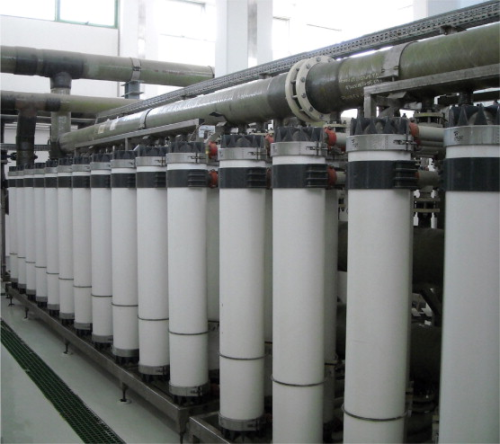
Emirates Steel Industries is undertaking a $444 million expansion of its steel plant in Mussafah, Abu Dhabi, UAE. The expansion will increases production from 600,000 tonnes per year to three million tonnes in 2011, and the size of its existing seawater desalination facility will be doubled to 80,000 m3/day. The current desalination facility was designed and built by Bernardinello Engineering S.p.A., and is equipped with UF pre-treatment from inge watertechnologies AG. The company has also been selected to provide the new plant, which will be a duplicate of the original.
The water in the Arabic Gulf is known for its very challenging nature for reverse osmosis (RO) seawater desalination. The water is relatively shallow and the temperatures are high. Many small islands off the coast reduce the water exchange with the open sea. This results in seawater with high salinity, high organic content and microbiological activity, posing a very high fouling risk for the RO membranes. A carefully designed pre-treatment with state of the art technology is absolutely essential to ensure economical plant operation. In difficult waters ultrafiltration (UF) has proven to be the best technology as the final pre-treatment step prior to RO.
UF delivers superior water quality compared with conventional treatment due to the defined, very fine pore structure. It delivers a continuously good filtrate quality independent of feed water quality variability caused by, for example, seasonal changes. Any UF systems used in the Arabic Gulf region are dependent upon a high-performance, extremely resilient membrane with excellent anti-fouling properties which is capable of properly dealing with the water's organic content.
The modules supplied by inge watertechnologies have proved capable of meeting these requirements since they came online in January 2009, and the German-made dizzer modules have now been chosen for the project designed to expand the water treatment plant's capacity. Making sure that the membrane you choose is highly resilient is a crucial factor - especially when it comes to a major project involving the treatment of 80,000 m3 of water per day. That is why the Italian plant construction firm Bernardinello Engineering S.p.A. selected a combination of dissolved air flotation (DAF) and UF systems to condition the water prior to a two-pass RO system. For the UF they chose to use Multibore membrane from inge watertechnologies.
The project to expand the plant will now see a total of 574 dizzer 5000 plus modules – each featuring a 50 m2 membrane surface area – coming online from 2011 onwards in a layout of seven racks. The job of these modules is to pre-treat the seawater to prepare it for reverse osmosis. The UF facility is also used to treat the blowdown water from the steel works cooling towers. Ralf Kruger, the sales manager responsible for this project at inge watertechnologies, sums up what is required, “The mixture of seawater and process water in the treatment facility makes this project particularly challenging. Approximately 10% of the feedwater comes from the production process. The specific requirements stipulated for this facility included achieving SDI values below two – even though the raw water often has an SDI value in excess of 15. Fortunately the technology we supply is capable of reliably ensuring that kind of performance over the long term.”
How does it work in Mussafah?
Approximately 90% of the feedwater enters the system through an open sea intake, with the remainder being recycled from the steel rolling mill's cooling water system. After this, the open intake hypochlorite and polyaluminiumchloride (PAC) are dosed to the seawater. The PAC is used as a coagulant for the dissolved air flotation unit. The main task of the DAF unit is the removal of oil and grease which might clog the membrane surface. During the summer when the raw water quality is even more difficult to treat, it also helps to reduce turbidity, organics and suspended matter ahead of the ultrafiltration. The UF system purifies the water in terms of biological, organic and particulate contaminants before it enters the two pass RO system.
Upstream of the UF an inline coagulation unit is installed for optional use depending on feed water conditions. By dosing ferric chloride the inline coagulation creates micro flocks which prove to be especially beneficial in water with a high organic content. The flocks reduce compaction of the fouling layer, improving the backwash efficiency and overall performance of the UF membranes. At the same time organics are embedded in the flocks, increasing the organics rejection and reducing biological fouling not only on the UF membrane but on the RO membranes as well. The UF is operated in dead end mode with a design flux of slightly more than 72 l/m2h in filtration mode. The flux rate is relatively low for seawater but due to the special circumstances in the Arabic Gulf a fairly low flux was chosen.
The UF's inside-out filtration cycle operates at 72 Lmh (43 gfd) for 25 minutes until the fibres are backwashed. To control biological fouling and maintain a transmembrane pressure (TMP) of 0.1 to 0.2 bar, chemically enhanced backwashes (CEB) are carried out using sodium hypochlorite with approximately 20 mg/L of residual chlorine and a soak time of 5–10 minutes up to six times a day. After the initial start-up, the DAF consistently produced water with an SDI15 of 4.6 and a turbidity of 5.3, while the UF filtrate stabilized at approximately 0.4 SDI15. The first pass concentrate is discharged to the sea, while the second pass concentrate is recirculated to the feed of the first pass. The RO produces water with a TDS of approximately 20 mg/L for use in the steel production process, and for make-up water for the cooling water cycle.





